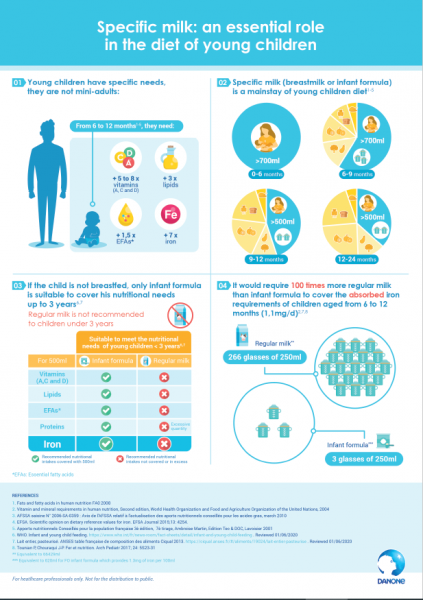In infants and children, iron is a fundamental element for optimal growth, cognitive development and immune system development1-3. During this period of opportunity, the environment and nutrition in particular, have the ability to influence the future health of the child4.
SPECIFIC NUTRITIONAL NEEDS
A young child shows rapid growth during which their organs develop: he therefore has specific nutrient requirements, more important than an adult. Indeed, at 1 year old, a child needs 7 times more iron (per kg/body mass), but also 5 to 8 times more vitamins, 3 times more lipids and 1.5 times more essential fatty acids than an adult5-9. These needs can be met with a balanced diet.
During the first 6 months, iron requirements are mainly covered by the newborn’s prenatal reserves and breast milk10. After 6 months, breast milk alone (or failing that, infant milk alone) is insufficient to cover the child’s growing needs, hence the need for a well-absorbed iron-rich supplemental diet11.
THE ROLE OF IRON IN CHILD DEVELOPMENT
Iron is an essential micronutrient for the proper functioning of the immune system, cognitive development and optimal growth1-3.
Iron deficiency has serious short- and long-term consequences for the child12-14:
- Anemia
- Disrupted or delayed growth
- Impaired brain and psychomotor development
- A weakened immune system and an increased risk of infection
THE ESSENTIALITY OF SPECIFIC MILK
Specific milk (maternal or failing that infant milk) is a pillar of the young child’s diet until he is 3 years old5-9. In order to cover its growing nutritional needs, it is therefore necessary to prioritize a well-absorbed iron.
Breast milk contains a small amount of iron but with a high bioavailability (50%) due to lactoferrin, which allows it to meet the child’s specific nutritional needs13. When the child is not breastfed, only infant milk is suitable to cover iron requirements because its bioavailability is 10 to 20% compared to only 1 to 5% in plain cow’s milk12.
Discover a playful tool to share with parents to easily explain the importance of specific milk in the child’s diet.
Find the interview with Professor Mohamed El Barbary during the 11th edition of the African Meeting of Infant Nutrition (RANI) on the importance of iron in the first 1000 days:

Infography : Specific milk, an essential role in the child’s diet
References
- Bailey RL et al. The epidemiology of global micronutrient deficiencies. Ann Nutr Meta 2015; 66 Suppl 2: 22-33
- Wang M. Iron deficiency and other types of anemia in infants and children. Am Fam Physician 2016; 93: 270-8.
- Hassan TH et al. Impact of iron deficiency anemia on the function of the immune system in children. Medicine (Baltimore) 2016; 95(47): e5395
- Schwarzenberg SJ et al. Advocacy for Improving Nutrition in the First 1000 Days to Support Childhood Development and Adult Health. Pediatrics 2018; 141: e20173716.
- Fats and fatty acids in human nutrition FAO 2008
- Vitamin and mineral requirements in human nutrition, Second edition, World Health Organization and Food and Agriculture Organization of the United Nations, 2004
- AFSSA saisine N°2006-SA-0359 : Avis de l’AFSSA relatif à l’actualisation des apports nutritionnels conseillés pour les acides gras, mars 2010
- EFSA. Scientific opinion on dietary reference values for iron. EFSA Journal 2015; 13: 4254
- Apports nutritionnels Conseillés pour la population française 3è édition, 7è tirage, Ambroise Martin, Edition Tec & DOC, Lavoisier 2001
- Lapillonne, A., and O. Becquet. “Recommandations pour les apports en fer pendant les six premiers mois de vie.” Archives de Pédiatrie 24.5 (2017): 5S40-5S44.
- Brannon, Patsy M., and Christine L. Taylor. “Iron supplementation during pregnancy and infancy: Uncertainties and implications for research and policy.” Nutrients 9.12 (2017): 1327.
- Tounian, P., and J-P. Chouraqui. “Fer et nutrition.” Archives de Pédiatrie 24.5 (2017): 5S23-5S31.
- Diouf, S., et al. “Prévalence et déterminants de l’anémie chez le jeune enfant en Afrique francophone–Implication de la carence en fer.” Archives de Pédiatrie 22.11 (2015): 1188-1197.
- De Pontual, L. “Fer et prédisposition aux infections.” Archives de Pédiatrie 24.5 (2017): 5S14-5S17.
BA20-464
